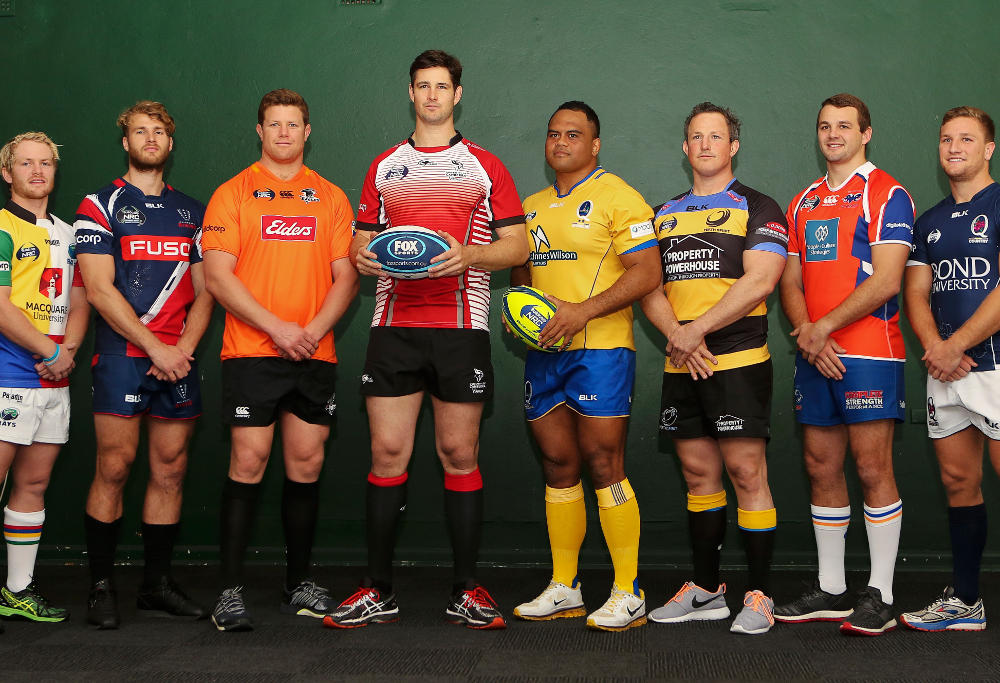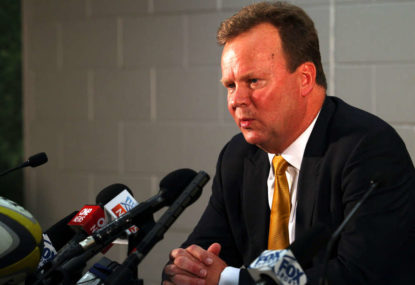The question all rugby tragics would like answered is; what is wrong with the rugby in Australia at the moment?
Much has been written and discussed about the plight of Australian rugby in recent times. Put simply, the Wallabies have forgotten how to win, while Super Rugby franchises are floundering under a shroud of uncertainty and appear to lack definitive leadership.
Although the Wallabies have won a Rugby World Cup or two and been in a couple of finals, of late, something has gone amiss.
The ARU is financially propping up struggling franchises, the Grim Reaper is one fell swoop away from wielding his scythe through either the Rebels or Force and threats of lawsuits hang over the Australian Rugby Union (ARU).
In the meantime, the ARU board drinks its woes away at expensive restaurants identifying fantasy Wallaby teams!
So, who has their hand on it, the tiller, to steer the boat?
Local rugby is struggling to preserve whatever vestige of decency and relevance in sport. It appears that to survive and remain relevant in the midst of professionalism, local rugby relies on chook raffles and canteen sales for those teams without generous benefactors.
Some clubs sold off assets in an attempt to be competitive in a semi-professional environment, yet continue to struggle to be competitive.
Where was the support to enable clubs an equal footing in their relevant competition, to be competitive and not have a rich club attract talent and the poor clubs fight for what is left? Limited pathway opportunities existed or were promoted.
That in itself is not healthy, as these teams now fight for relevancy because Super Rugby franchises and the ARU display indifference to supporting grass roots and assisting the development of professional coaches and talented players.

(Source: NSW Rugby Union).
Allocating a few ‘off-duty’ Super Rugby players across rugby clubs every now and then to strengthen the competition is not working.
What is essentially saving some clubs from folding is club culture, their history and a continuing desire to field teams. This is why we see these clubs continue to fight and struggle in an ‘amateur’ way against better-resourced operations.
Maybe the ARU has become increasingly more reliant on the traditional rugby nurseries to do the heavy lifting?
We are getting schoolboys fast-tracked into Super Rugby programs without having grazed their knees at club level, where a few hard heads sort the chaff from the hay. Sure, some make it through to be good second tier players, but that is where it stops – a glass ceiling of sorts.
From where and how do we develop these young and talented men? To whom do we entrust their development? A lot of theories abound and just as many are swatted away by the St Leonards bunker as irrelevant or unworkable.
We need to remember that we are not unique in Australia and rugby is not a unique sport here. If those who wear a GPS or Sydney Uni tie think that to be the case, then therein lies part of the problem with Australian rugby.
We have had sports administrators come and go – and come and go again – as the head of the ARU and the Super Rugby franchises. It would be fair to say that rugby in Australia is in a worse position both financially and professionally since its halcyon days.
An opportunity lost when, after the Rugby World Cup, the ARU had a healthy cash balance of $18m. Similar issues exist at one or two of the Super Rugby franchises, where healthy cash balances have apparently vanished, without benefiting grass roots rugby.
It appears that some sporting administrators are there for their own aggrandisement rather than identifying ways to develop the game.
Where is the leadership in Australian rugby?

(AP Photo/Rick Rycroft)
New South Wales and Queensland rugby is in the doldrums and ACT rugby is rebuilding itself after a shambolic relationship with sociopathic leadership and shady business deals. These traditional rugby nurseries are the backbone of Australian rugby. There are only so many players that can be developed in NSW, Queensland and ACT.
It may be because if schoolboys want to play a rugby code, they select league unless they are in a school system which promotes rugby or they follow their father’s desire to play rugby.
In comparison, the league nursery is full of talent – a regular junior competition supported by the NRL as well as schoolboy based tournaments. NRL talent scouts are out and about identifying talent, running coaching clinics and supporting local junior clubs.
The ARU response is an annual schoolboy carnival. That’s it!
‘Oh, but that has served us well in the past’, I hear the old boys’ tie brigade protest.
Well, this ain’t Kansas anymore. For all the business acumen and strategic talent which exists in rugby boardrooms across the nation, the administration is being outsmarted and out-manoeuvred by competing sporting codes.
The ARU was keen to increase the number of Super Rugby franchises to develop a deeper talent pool, but this has had mixed results.
More players became professional, but many of them are probably some way off being solid second-tier professionals. Franchises have had to look at imports to bolster their rosters and enable them to field a competitive team or replace talented players who retire or take up lucrative offers overseas.
From this perspective, a five franchise structure has not been the success that had been envisaged in developing a deeper player pool.
A look at the current Wallaby squad and the backup players available will illustrate this supposition. One only needs to watch Super Rugby games to realise that, as a rugby playing nation, the talent is thin and skillset rudimentary.
There was a sniff of a National Rugby Championship (NRC) some time back, with the sole intention of providing talented players with the opportunity to be exposed to a professional environment and play in a stronger competition – further developing key skills, speed and game psychology.
But that wafted away quickly. Admittedly, the ARU was bleeding financially and the cumulative loss of the NRC was approximately $5 million over two years.
Any business minded organisation would soon realise that this was fiscally irresponsible and unsustainable in the modern professional era, but this decision left a third tier competition floundering for years.
Would rugby in Australia be better today had the original competition been maintained and given adequate funding and sponsorship?

The NRC didn’t last long. (Photo Karen Watson)
We also need to remember that the ARU paid ABC to broadcast the competition. This would suggest the NRC was a thought bubble, quickly promulgated into a competition without adequate due diligence and clear financial governance considerations.
Today, as a result of poor decision making and the fact Australian franchises did not, or were unable to, support the NRC to the extent needed, players did not have the exposure to a third tier competition with the sole purpose of being further developed.
We were therefore reliant on local rugby competitions and schoolboy championships in bringing forward the next crop of Super Rugby representatives.
Why is it that our promising players seem to be happy to strive towards mediocrity? Interviews with potential Super Rugby players revolve around hoping to get a Brumbies or Waratahs or Reds contract.
Humble? Possibly. Confident? Not that I can tell.
What should an up and coming player strive for? Setting goals is important, but should those goals be offers of a contract or making a final series or should it be to reduce errors, improve on their weaknesses and strive to be the best positional player in the competition?
Tick those boxes, change the mindset and the rest looks after itself. Self-belief is paramount to success. Do the current crop of Super Rugby or representative players strive to improve skill levels or are they more interested in meeting KPIs and resting on laurels once they reach their goal of a Super Rugby contract or a Wallaby jumper?
Our performance tells the story.
To address skillset issues, we need to invest in strong and influential coaches who are good managers and above all, sound leaders. This needs to be consistent across all franchises and developed from the grass roots.
To the ARU’s credit, they have developed a national coaching panel, with the intention to support the development of coaches across all levels of the game. For example, Steven Larkham will be based in Canberra when not on national duty and will support the Brumbies coaching staff.
But more importantly, this support must translate to coaches identifying talent, better managing player development and players becoming technically adept in their roles – and this support needs to trickle down to clubs and schools.
It’s time that our provincial and national rugby representatives showed leadership, set aside their parochial state-based differences and worked collegially to fix our game’s malaise.
The rugby states need to build relationships between themselves and the ARU. These relationships need to be strong so that each state can challenge the paradigm and work together to resolve conflict because, at the end of the day, we all want the same thing.
We, the rugby community, want Australian rugby to be the powerhouse in world rugby that it deserves to be and can be.
But until the ARU makes the decision to reduce the number of Australian teams to four, proposed lawsuits are thrown out the door and the board rooms move on from this turmoil, this may be a bridge too far.
The reverberation of a reduced Australian rugby landscape will be felt for some time to come unless state peak bodies show unity and solidarity.

































































































